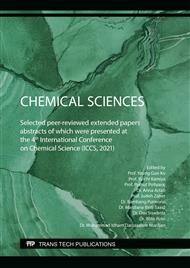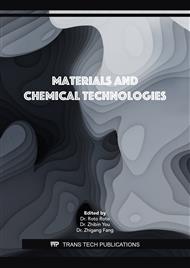[1]
F. Giornal, S. Pazenok, L. Rodefeld, N. Lui, J.P. Vors, F.R. Leroux, Synthesis of diversely fluorinated pyrazoles as novel active agrochemical ingredients, J. Fluorine Chem. 152 (2013) 2–11.
DOI: 10.1016/j.jfluchem.2012.11.008
Google Scholar
[2]
R. Román, A. Navarro, D. Wodka, M. Alvim-Gaston, S. Husain, N. Franklin, A. Simón-Fuentes, S. Fustero, Synthesis of fluorinated and nonfluorinated tebufenpyrad analogues for the study of anti-angiogenesis MOA, Org. Process Res. Dev. 18 (2014) 1027–1036.
DOI: 10.1021/op500114v
Google Scholar
[3]
Q.W. Zhang, J.F. Hartwig, Synthesis of heteroaromatic trifluoromethyl ethers with trifluoromethyl triflate as the source of the trifluoromethoxy group, Chem. Commun. 54 (2018) 10124–10127.
DOI: 10.1039/c8cc05084h
Google Scholar
[4]
E. Schmitt, S. Bouvet, B. Pégot, A. Panossian, J.P, Vors, S. Pazenok, E. Magnier, F.R. Leroux, Fluoroalkyl amino reagents for the introduction of the fluoro(trifluoromethoxy)methyl group onto arenes and heterocycles, Org. Lett. 19 (2017) 4960–4963.
DOI: 10.1021/acs.orglett.7b02444
Google Scholar
[5]
J.C. Sloop, C. Holder, M. Henary, Selective incorporation of fluorine in pyrazoles, Eur. J. Org. Chem. 2015 (2015) 3405–3422.
DOI: 10.1002/ejoc.201500258
Google Scholar
[6]
E. Schmitt, A. Panossian, J.P. Vors, C. Funke, N. Lui, S. Pazenok, F.R. Leroux, A major advance in the synthesis of fluoroalkyl pyrazoles: Tuneable regioselectivity and broad substitution patterns, Chem. - Eur. J. 22 (2016) 11239–11244.
DOI: 10.1002/chem.201601621
Google Scholar
[7]
M. Abdel-Halim, B. Diesel, A.K. Kiemer, A.H. Abadi, R.W. Hartmann, M. Engel, Discovery and optimization of 1,3,5-trisubstituted pyrazolines as potent and highly selective allosteric inhibitors of protein kinase C-ζ, J. Med. Chem. 57 (2014) 6513–6530.
DOI: 10.1021/jm500521n
Google Scholar
[8]
P. Ahmad, H. Woo, K.Y. Jun, A.A. Kadi, H.A. Abdel-Aziz, Y. Kwon, A.M. Rahman, Design, synthesis, topoisomerase I & II inhibitory activity, antiproliferative activity, and structure–activity relationship study of pyrazoline derivatives: An ATP-competitive human topoisomerase IIα catalytic inhibitor, Bioorg. Med. Chem. 24 (2016) 1898–(1908).
DOI: 10.1016/j.bmc.2016.03.017
Google Scholar
[9]
Y.J. Qin, Y.J. Li, A.Q. Jiang, M.R. Yang, Q.Z. Zhu, H. Dong, H.L. Zhu, Design, synthesis and biological evaluation of novel pyrazoline-containing derivatives as potential tubulin assembling inhibitors, Eur. J. Med. Chem. 94 (2015) 447–457.
DOI: 10.1016/j.ejmech.2015.02.058
Google Scholar
[10]
T. Mosmann, Rapid colorimetric assay for cellular growth and survival: Application to proliferation and cytotoxicity assays, J. Immunol. Methods 65 (1983) 55e63.
DOI: 10.1016/0022-1759(83)90303-4
Google Scholar
[11]
J.J. Liu, H. Zhang, J. Sun, Z.C. Wang, Y.S. Yang, D. Li, F. Zhang, H.B. Gong, H.L. Zhu, Synthesis, biological evaluation of novel 4, 5-dihydro-2H-pyrazole 2-hydroxyphenyl derivatives as BRAF inhibitors, Bioorg. Med. Chem. 20 (2012) 6089–6096.
DOI: 10.1016/j.bmc.2012.08.020
Google Scholar
[12]
E.C. McLoughlin, N.M. O'Boyle, Colchicine-binding site inhibitors from chemistry to clinic: A review, Pharmaceuticals 13 (2020) 8.
DOI: 10.3390/ph13010008
Google Scholar
[13]
Y. Lu, J. Chen, M. Xio, W. Li, D.D. Miller, An overview of tubulin inhibitors that interact with the colchicine binding site, Pharm. Res. 29 (2012) 2943–2971.
DOI: 10.1007/s11095-012-0828-z
Google Scholar
[14]
M. Dong, F. Liu, H. Zhou, S. Zhai, B. Yan, Novel natural product-and privileged scaffold-based tubulin inhibitors targeting the colchicine binding site, Molecules 21 (2016) 1375.
DOI: 10.3390/molecules21101375
Google Scholar
[15]
C.A. Lipinski, F. Lombardo, B.W. Dominy, P.J. Freeney, Experimental and computational approaches to estimate solubility and permeability in drug discovery and development settings, Adv. Drug Delivery Rev. 23 (1997) 3–25.
DOI: 10.1016/s0169-409x(96)00423-1
Google Scholar
[16]
D. Ramírez, J. Caballero, Is it reliable to take the molecular docking top scoring position as the best solution without considering available structural data?, Molecules 23 (2018) 1038.
DOI: 10.3390/molecules23051038
Google Scholar
[17]
P.H.M. Torres, A.C.R. Sodero, P. Jofily, F.P. Silva-Jr, Key topics in molecular docking for drug design, Int. J. Mol. Sci. 20 (2019) 4574.
DOI: 10.3390/ijms20184574
Google Scholar



